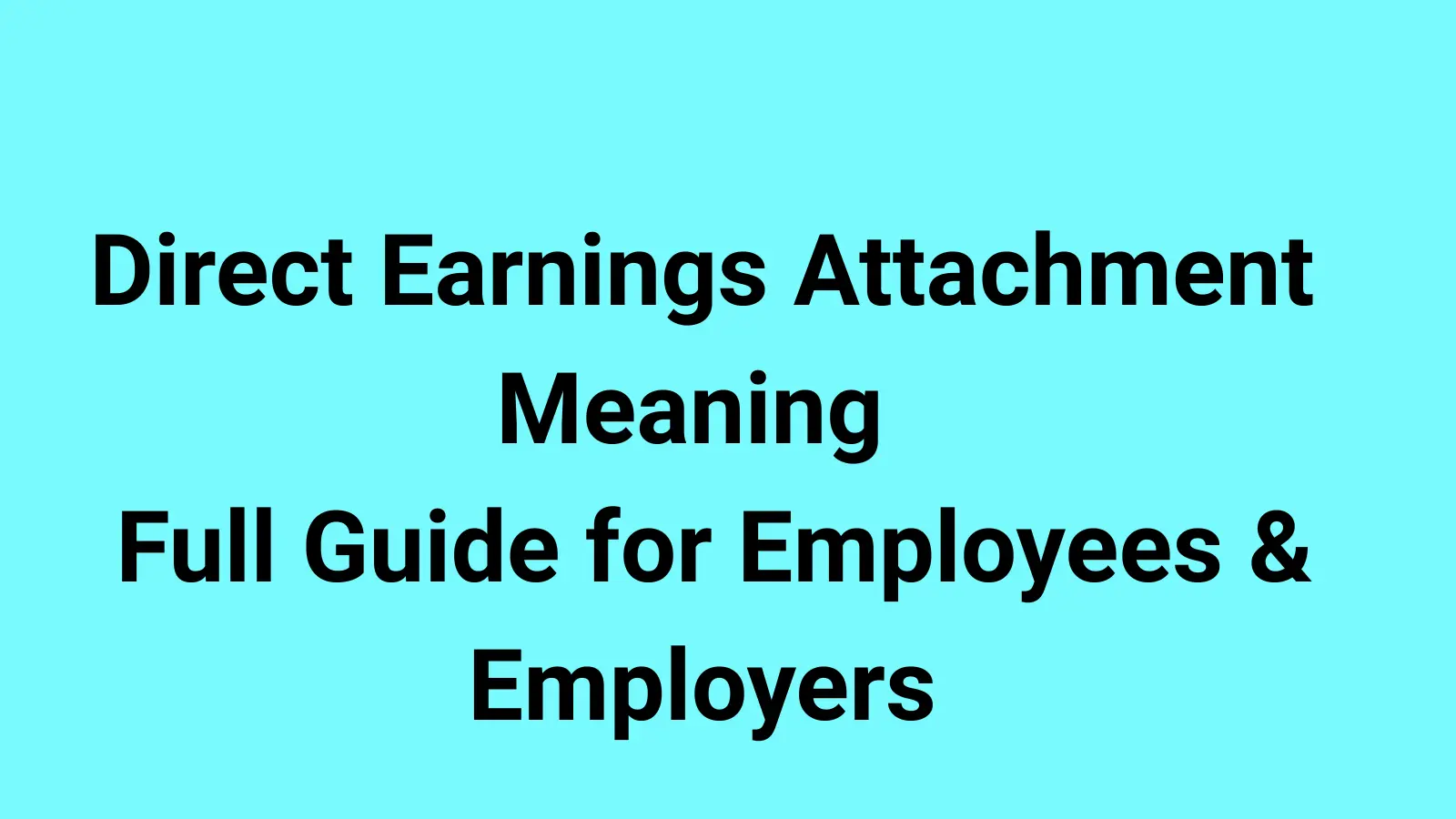When people first hear the term direct earnings attachment (DEA), they often wonder what it really means.
Put simply, the direct earnings attachment meaning refers to a legal process where money is deducted directly from an employee’s wages or salary by their employer, usually to repay debts owed to the government, such as overpaid benefits or unpaid fines.
Instead of chasing payments manually, a DEA allows authorities to collect debt directly from earnings in an organized and consistent way.
This article explains the meaning, purpose, examples, and implications of DEAs for employees, employers, and professionals.
📌 Direct Earnings Attachment Meaning Explained in Simple Terms
The phrase may sound technical, but here’s what it boils down to:
- 💷 It’s a wage deduction – Money comes straight out of your pay.
- ⚖️ It’s legally authorized – Employers are legally required to apply it.
- 📑 It’s debt recovery – Usually for government or council debts.
- 🏢 Handled by employers – Companies process deductions before paying staff.
- 🕰 Regular deductions – Payments happen each payday until cleared.
- 🏦 Not voluntary – Employees don’t choose, it’s enforced.
- 📉 Based on income – The amount depends on earnings level.
- 🚫 Not a criminal penalty – It’s debt-related, not a criminal record.
- 🔄 Ongoing process – Continues until the debt is repaid.
- 🛡 Protection exists – Employees keep a minimum take-home pay.
- 📊 Transparent – Shown on payslips clearly.
- 📬 Triggered by notice – Employers receive instructions by letter.
- 🔍 Traceable – Each deduction is accounted for.
- 🤝 Balances fairness – Ensures debts are repaid without bankrupting workers.
📌 Direct Earnings Attachment Meaning for Employees
If you’re an employee, here’s what a DEA means for you:
- 💷 Money comes out of wages before you’re paid.
- 📃 You’ll be notified by your employer or the authority.
- 🛡 You can’t stop it, but you’re protected from excessive deductions.
- 📊 Deduction rates depend on income bands.
- 🏦 Your net pay will be lower, so budgeting changes are needed.
- ⚖️ It’s legally binding – non-payment isn’t an option.
- 📋 Payslips will show DEA details.
- 🤔 You may contact the authority if you dispute the debt.
- 📞 Communication is possible if struggling financially.
- 🕰 Deductions continue until the balance is cleared.
- 🚫 You won’t face jail – it’s civil, not criminal.
- 🏠 Could affect household budgeting.
- 📚 Important to understand your rights.
- 🌍 A common system across the UK.
📌 Direct Earnings Attachment Meaning for Employers
Employers play a key role in making DEAs work smoothly:
- 🏢 Must comply with DEA instructions.
- 💼 HR/payroll departments manage deductions.
- 📬 Receive official notice from authorities.
- 💷 Deduct money directly from wages.
- 📑 Must keep accurate records.
- 📊 Payments are forwarded to the authority.
- 🕰 Done every payday, without delay.
- 🤝 Required by law – ignoring notice is not an option.
- 🛡 Employers must not penalize employees unfairly.
- 📋 Payslips must reflect deductions clearly.
- 📞 Queries may come from staff.
- ⚖️ Legal consequences if ignored.
- 🔄 Continues until notified to stop.
- 📲 Employers may recover small admin costs.
📌 Direct Earnings Attachment Meaning in UK Law
The DEA framework in the UK is legally structured:
- 📜 Introduced under Social Security legislation.
- 🏛 Used by the Department for Work and Pensions (DWP).
- 🏘 Local councils may also issue DEAs.
- ⚖️ Governed by clear regulations.
- 🕰 Regular deductions on payday.
- 💷 Based on net earnings thresholds.
- 🛡 Protected minimum earnings apply.
- 🚫 Cannot deduct below certain levels.
- 📑 Employers must follow exact guidelines.
- 📝 Employees are informed in writing.
- 📊 Sliding scale percentages apply.
- 🏦 Works like other attachment orders.
- 📬 Stops once debt is paid.
- 🧩 Covers benefit overpayments, fines, etc.
📌 Types of Direct Earnings Attachments
Not all DEAs are identical; they vary depending on context:
- 📘 Standard DEA – Regular deductions until cleared.
- 📕 DEA for overpaid benefits – Common for welfare debt.
- 📙 DEA for civil penalties – Repays fines or charges.
- 📗 DEA for loans – Sometimes applied to unpaid advances.
- 📒 DEA for fraud – Linked to fraudulent overpayments.
- 📔 Voluntary DEA – Rare, but sometimes agreed.
- 📓 Reduced-rate DEA – For lower-income workers.
- 📕 Council DEA – Issued by local councils.
- 📗 DWP DEA – Issued by Department for Work and Pensions.
- 📘 Fixed-term DEA – Ends once a specific sum is recovered.
- 📙 Variable-rate DEA – Adjusted if income changes.
- 📒 Hybrid DEA – Where multiple debts exist.
- 📓 Multiple DEAs – More than one at the same time (rare).
- 📔 Stopped DEA – Ceases once authority recalls it.
📌 Direct Earnings Attachment Meaning with Real-Life Examples
Here’s how DEAs might look in everyday life:
- 👩💼 Emma earns £1,500/month. A DEA deducts 5%, so £75 is taken.
- 👨🔧 Tom works part-time. He earns below the threshold, so no deduction is made.
- 👩🏫 Sarah overpaid £1,200 in benefits. Deductions continue until cleared.
- 👨💻 Jake’s employer receives a DEA notice and applies it from next payday.
- 🛒 Laura’s payslip shows “DEA deduction: £60.”
- 🕰 Michael’s DEA lasts six months until debt ends.
- 📊 Sophie has multiple debts – DEA prioritizes certain ones.
- 📑 Harry disputes the debt – deductions pause temporarily.
- 💼 Employers add £1 admin cost each deduction.
- 🤝 DEA ensures regular repayments without chasing.
- 🚫 Alex ignores debt letters – DEA forces repayment.
- 📲 Maria sees reduced pay and asks HR for details.
- 🏠 James adjusts his budget due to lower take-home pay.
- 📚 Priya reads government guidance to understand her DEA.
📌 Direct Earnings Attachment Meaning vs. Other Orders
DEAs differ from similar processes:
- 🏦 Attachment of Earnings Order (AEO): Court-issued, broader debts.
- 💷 DEA: Specific to government debts.
- 🏛 Council Tax Attachment: For unpaid council tax.
- ⚖️ Child Maintenance Deduction: To ensure parental contributions.
- 📑 Tax Codes: HMRC can alter PAYE for debts.
- 📊 Direct Debit: Voluntary, unlike DEA.
- 💼 Employer Garnishment: US version of wage deductions.
- 🏠 Rent Deduction Orders: Separate for housing debt.
- 🕰 Court Fines Deduction: Through magistrates’ courts.
- 📘 Benefit Deductions: Taken before benefits paid, not from wages.
- 📕 Voluntary Repayments: Chosen, not enforced.
- 📗 County Court Judgement (CCJ): May trigger earnings deductions.
- 📒 Attachment Orders: Umbrella term for similar mechanisms.
📌 Direct Earnings Attachment Meaning for Different Audiences
- 👶 Teens starting work: Learn why deductions might appear.
- 👩🎓 Students: If working part-time, may still face DEAs.
- 👨👩👧 Parents: Understand DEAs impact household income.
- 🧑💼 Professionals: See it as compliance, not punishment.
- 👴 Older workers: May confuse with pension deductions.
- 🏢 Employers: Obligated to handle accurately.
- 📚 Researchers: Useful case study in social policy.
- 📊 Economists: Reflects government debt collection methods.
- ⚖️ Lawyers: Know regulations behind DEAs.
- 📰 Journalists: Report stories on rising deductions.
- 💬 General public: Learn their rights.
- 🌍 International readers: Compare to wage garnishments abroad.
- 🤝 Advisers: Support clients with DEAs.
- 🏦 Financial planners: Help adjust budgets around DEAs.
📌 Direct Earnings Attachment Meaning: Pros and Cons
Like any system, DEAs have positives and negatives:
✅ Pros:
- Guarantees debt recovery.
- Reduces admin for government.
- Ensures fairness.
- Transparent deductions.
- Easier than chasing debtors.
- Employers recover admin costs.
- Helps clear debts gradually.
❌ Cons:
- Reduces take-home pay.
- Can feel harsh to employees.
- Limited flexibility.
- Employers handle extra work.
- May strain household budgets.
- Misunderstandings can occur.
- Emotional stress for employees.
📌 FAQs About Direct Earnings Attachment Meaning
Q1: What is the direct earnings attachment meaning?
👉 It’s a process where money is taken directly from wages to repay debt.
Q2: Who issues a DEA?
👉 Government departments like DWP or councils.
Q3: Can I stop a DEA?
👉 Only if debt is disputed or already paid.
Q4: How much can be deducted?
👉 Based on net earnings and legal thresholds.
Q5: Will my employer know about my debt?
👉 Yes, but they must keep it confidential.
Q6: Can multiple DEAs apply at once?
👉 Rare, but possible.
Q7: What if I lose my job?
👉 DEA stops until new employment is found.
Q8: Is DEA the same as wage garnishment?
👉 Yes, it’s the UK equivalent.
Q9: Do DEAs affect credit score?
👉 No direct impact, but debt history might.
Q10: What if I ignore DEA letters?
👉 Employer will still deduct once ordered.
📌 Conclusion: Understanding Direct Earnings Attachment Meaning
The direct earnings attachment meaning is simple yet important: it’s a legally enforced way for government authorities to recover debts by deducting money directly from wages.
For employees, it means budgeting with slightly less take-home pay. For employers, it’s about compliance and payroll accuracy.
For society, it’s a structured way of ensuring fairness in debt recovery. By knowing your rights, responsibilities, and protections, you can handle DEAs confidently and without unnecessary stress.



